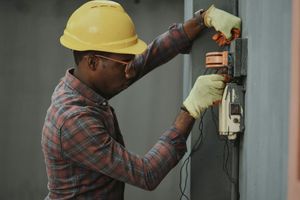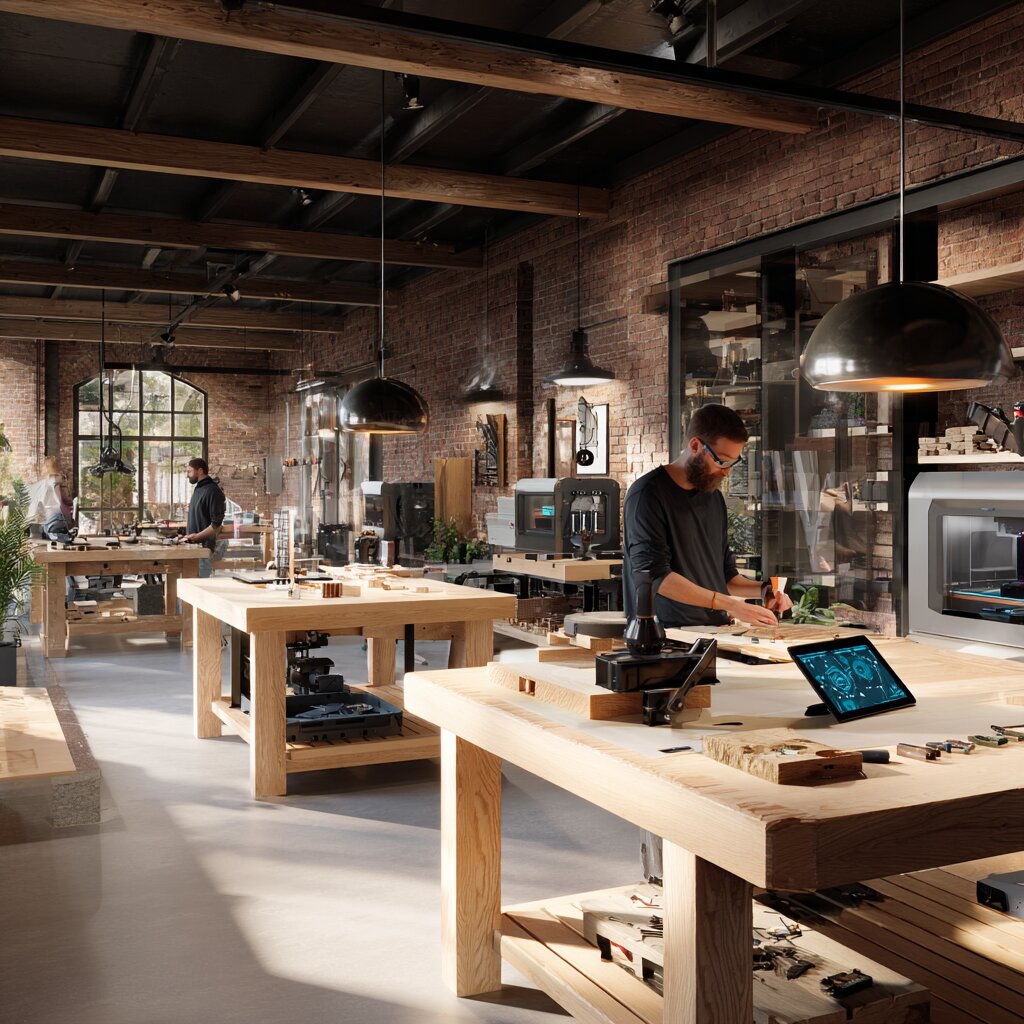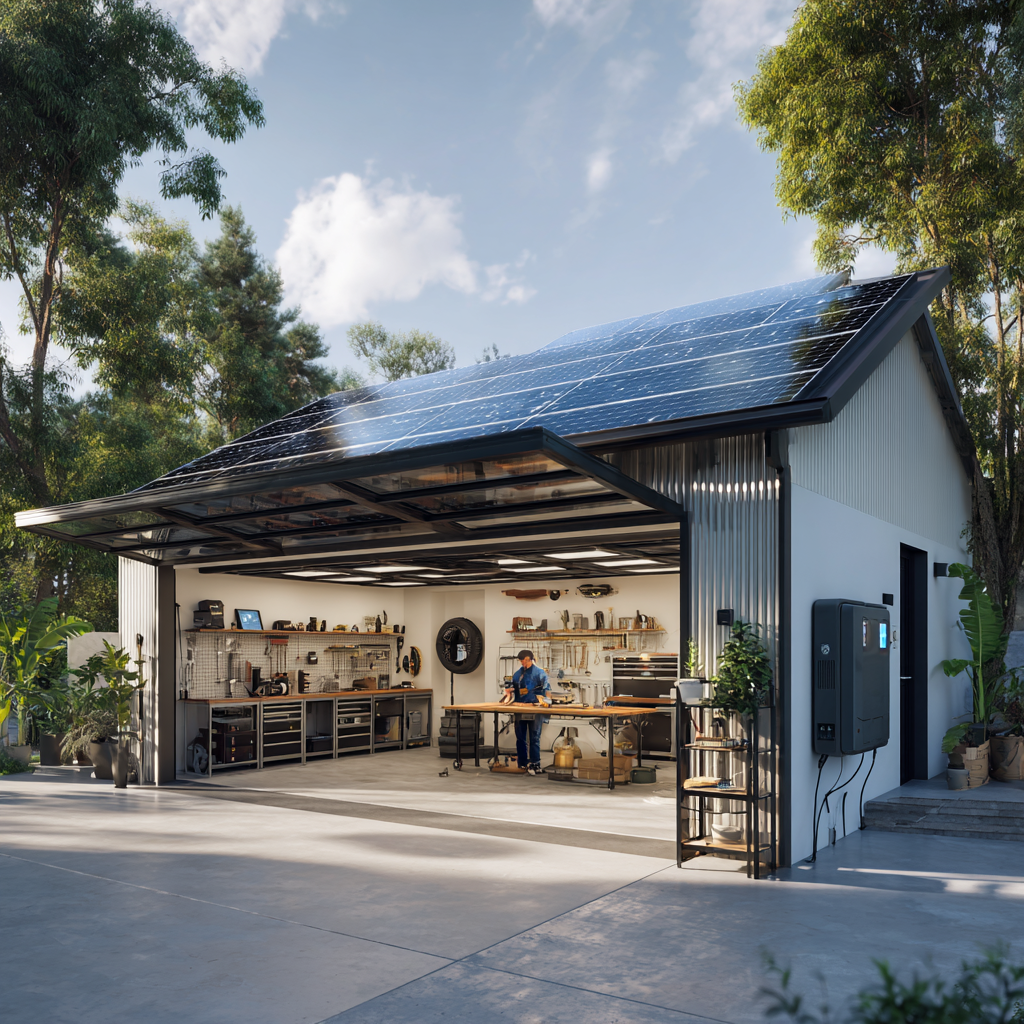Workshop Cooling Systems 2025: How to Maintain Comfortable Temperature Even in Extreme Heat

Transform Your Home Into a Smart Paradise - 2025 Guide
Discover the latest smart home technology that will revolutionize your daily routine.
Last July, I felt like I was in hell. The temperature in my workshop reached 109°F (43°C) and I was trying to grind metal parts. After twenty minutes, I was completely exhausted and my work looked like a beginner's attempt. I told myself: "Next year, this workshop will have air conditioning!"
Today, a year later, I work comfortably even when it's in the 90s outside. It wasn't cheap, but the investment paid off during the first hot week. Not only can I work longer, but mainly with much better results.
If you're planning to solve workshop cooling before this summer, you have perfect timing. Prices are still reasonable and supplies are available. In a month, everything will be sold out or double the price.
Why Address Workshop Cooling in 2025
Ever-rising temperatures: Meteorologists predict more temperature records Lower work quality: At temperatures above 86°F, work precision drops by 40% Health risks: Overheating in enclosed spaces is dangerous Tool damage: Electronics suffer at high temperatures
Personal experience: Last summer, overheating destroyed two cordless drills and a laser. Repair costs: $320. Air conditioning would cost the same and save my health too.
Types of Cooling Systems for Workshops
1. Portable Air Conditioners (Most Popular Solution)
Advantages of Portable Units
✅ Quick installation: Just drill a hole for the hose ✅ Flexibility: Can be moved as needed ✅ Lower costs: Compared to split systems ✅ No electrician needed: Plug into regular outlet
Disadvantages
❌ Higher consumption: 20-30% more than split systems ❌ Noise: 50-65 dB vs. 35-45 dB for split systems ❌ Takes space: About 16×16 inch footprint ❌ Need drainage: Condensate every 8-12 hours
Recommended 2025 Models
Budget category ($320-600):
- Daitsu APD 12-A: $480, 12,000 BTU, energy class A
- Electrolux EACM: $360, 9,000 BTU, compact design
- Midea MPPD: $440, 12,000 BTU, WiFi control
Mid-range category ($600-1000):
- De'Longhi Pinguino: $720, 14,000 BTU, very quiet
- Stiebel Eltron: $880, German quality, long lifespan
- Trotec PAC 4600: $800, industrial grade
Premium category ($1000-1600):
- Dyson Pure Cool: $1400, cooling + air purification
- LG Dual Cool: $1120, dual-channel cooling
- Mitsubishi Heavy: $1280, Japanese reliability
Power Requirement Calculation
Basic calculation:
Workshop volume (ft³) × 25 BTU = required output (BTU)
Example:
Workshop 13×16×8 ft = 1,664 ft³
1,664 × 25 = 41,600 BTU (3.5 ton)
Correction factors:
+ 20% for each large south-facing window
+ 30% for metal roofs
+ 15% for electronic tools (welding)
+ 10% for poor insulation
2. Split Systems (Highest Efficiency)
Stationary Split Systems
Split Advantages:
- Best efficiency: SEER up to 20 (high efficiency rating)
- Quiet operation: Indoor unit only 19-35 dB
- Long lifespan: 15-20 years with proper maintenance
- Heating capability: Inverter models heat in winter too
Disadvantages:
- Electrician required: Installation needs professional
- Higher initial costs: $1000-2400 including installation
- Lower flexibility: Fixed installation
Recommended Split Systems for Workshops
Economic models ($1000-1400 including installation):
- Midea Mission Pro: $1120, 12,000 BTU, basic functions
- Gree Lomo: $1040, 11,000 BTU, good value
- TCL Elite: $1200, 12,000 BTU, 5-year warranty
Mid-range ($1400-2000):
- LG Standard Plus: $1680, 12,000 BTU, WiFi, quiet
- Samsung Wind-Free: $1800, wind-free cooling
- Panasonic Etherea: $1920, nanoe-X technology
Premium category ($2000-3200):
- Daikin Emura: $2600, design icon, SEER 20
- Mitsubishi Electric MSZ: $2880, best in test
- Fujitsu Designer: $2320, elegant appearance
3. Evaporative Coolers (Eco-Friendly)
Operating Principle
Cooling effect of water evaporation - old but still effective solution for dry climates.
Evaporative Cooling Advantages:
- Very low consumption: 150-300W vs. 2000-4000W for AC
- Natural humidification: Ideal for dusty environments
- Fresh air: Doesn't work with recirculation
- Low costs: $200-600 for quality unit
Disadvantages:
- Works only in dry climate: Ineffective above 60% humidity
- Cools only 15-25°F: Compared to AC (35-45°F difference)
- Water refilling needed: 1-5 gallons daily
- Maintenance: Clean supply pads weekly
Recommended Evaporative Coolers
Small workshops (up to 320 ft²):
- Klarstein Maxfresh: $320, 65W, 3-gallon tank
- Honeywell CL30XC: $480, 320W, air ionization
- Master CCX 4000: $240, 240W, robust design
Large workshops (320-860 ft²):
- Master BC 80: $600, 550W, industrial grade
- Biemmedue EC55: $720, Italian quality
- Thermobile COOL 18: $880, German precision
4. Fans and Air Circulation
Ceiling Fans (Basic Solution)
Size by space:
Workshop up to 160 ft²: 42" diameter
Workshop 160-270 ft²: 52" diameter
Workshop 270-430 ft²: 60" diameter
Workshop over 430 ft²: multiple fans or industrial solution
Top 2025 Models:
- Hunter Builder Plus: $180, 52", 10-year warranty
- Westinghouse Comet: $128, robust construction
- Casafan Eco Plano: $232, very quiet (13 dB)
Industrial Fans
For large spaces over 540 ft²:
- Master DF 20P: $320, 6000 m³/h airflow
- Dantherm TTV 4500: $480, Danish quality
- Vortice CA 160: $600, three-phase power
5. Hybrid Systems (2025 Trend)
Air Conditioning + Ventilation
Combination for optimal cost/performance:
- AC for extreme days (5-10× annually)
- Ventilation for regular summer days (30-40× annually)
- Total costs: 40-60% compared to AC only
Smart Control
Automated systems:
- Temperature/humidity sensors: $32-80
- Smart thermostats: $100-320
- App control: Remote activation before arriving at workshop
Installation Planning
Optimal Location Selection
Air Conditioning - Where to Place Indoor Unit
✅ Ideal position:
- 6-10 feet above ground
- Facing work area (not directly above)
- Adequate ventilation around unit (20 inches)
- Easy access for maintenance
❌ Unsuitable locations:
- Directly above work table (draft)
- Near heat sources (welder, compressor)
- Corners without air circulation
- High-dust areas
Outdoor Unit of Split System
Placement requirements:
- Stable foundation (concrete pad or brackets)
- Distance from windows min. 10 feet
- Adequate space for airflow
- Protection from rain and snow
Electrical Connection
Consumption and Electrical Installation
Typical consumption:
Portable AC 2.5 kW: 10-12 A (16 A circuit)
Split system 3.5 kW: 15-18 A (20 A circuit)
Evaporative cooler: 2-3 A (10 A circuit)
Fans: 1-2 A (10 A circuit)
Electrical installation check:
- Available power to breaker
- Grounding quality (required for AC)
- Distance from panel
- Possibility of separate circuit breaker
Electrical Installation Costs
- Portable AC: $0 (plug into outlet)
- Split system: $120-320 (new line + breaker)
- Industrial fans: $80-200 (three-phase line)
Operating Costs and Efficiency
Operating Cost Comparison (8 hours/day, 60 summer days)
Portable AC 12,000 BTU
Consumption: 1.2 kW/h (average with thermostat)
Daily costs: 1.2 × 8 × $0.12 = $1.15
Seasonal costs: $1.15 × 60 = $69
Split System 12,000 BTU (SEER 18)
Consumption: 0.8 kW/h (high efficiency)
Daily costs: 0.8 × 8 × $0.12 = $0.77
Seasonal costs: $0.77 × 60 = $46
Evaporative Cooler 300W
Consumption: 0.3 kW/h + water 4 gal/day
Daily costs: (0.3 × 8 × $0.12) + (4 × $0.002) = $0.30
Seasonal costs: $0.30 × 60 = $18
Ceiling Fan 75W
Consumption: 0.075 kW/h
Daily costs: 0.075 × 8 × $0.12 = $0.07
Seasonal costs: $0.07 × 60 = $4
ROI Calculation
Investment Return with Reduced Downtime
Example: Metalworking
- Work losses on hot days: 30% (2.4 h out of 8h)
- Hourly work rate: $16/h
- Loss per hot day: 2.4 × $16 = $38
- Hot days annually: ~15
- Total annual loss: $570
AC Investment: $1200 Payback: 2.1 years
Cooling System Maintenance
Portable AC - Monthly Maintenance
Filter Cleaning (every 2 weeks)
Process:
- Turn off and unplug
- Remove filter (usually from back)
- Rinse with warm water
- Dry for 24 hours
- Reinstall
Cost: $0 (DIY work) Time: 15 minutes
Condenser Cleaning (monthly)
Required tools:
- Fine bristle brush: $6
- Compressor or vacuum
- Condenser cleaning spray: $10
Process:
- Remove rear cover
- Blow dust with compressor
- Clean fins with brush
- Apply cleaning spray
- Reassemble
Split Systems - Professional Service
Recommended Service (annually)
Professional service includes:
- Cleaning indoor and outdoor units
- Refrigerant check and top-up
- Electrical connection check
- Function and noise testing
- Evaporator disinfection
Cost: $100-160/year Benefit: Extends life by 30-50%
DIY Maintenance (monthly)
What you can handle:
- Clean indoor unit filter
- Check condensate drain
- Clean around outdoor unit
- Check for loose connections
Evaporative Coolers
Weekly Maintenance
Cleaning sprayers:
- Empty tank
- Remove spray nozzles
- Rinse with hot water
- Check for clogs
- Install and fill with clean water
Water change: Complete every 3-4 days Tank cleaning: Every 14 days with vinegar solution
Selection and Installation Mistakes
❌ Mistake #1: Undersized Power
Problem: "I'll get by with smaller AC, it's cheaper" Consequence: AC runs non-stop, high consumption, early wear Solution: Always add 15-20% reserve to calculated power
❌ Mistake #2: Neglecting Ventilation
Problem: AC without ventilation = recirculating stale air Consequence: Fatigue, headaches, reduced productivity Solution: Combine cooling + controlled ventilation
❌ Mistake #3: Poor Placement
Problem: AC directly above work area Consequence: Draft, health problems, uneven cooling Solution: Indirect airflow, dispersed circulation
❌ Mistake #4: Forgetting Insulation
Problem: Cooling uninsulated workshop Consequence: 3× higher operating costs Solution: Basic ceiling and window insulation before AC installation
❌ Mistake #5: Unresolved Drainage
Problem: AC condensate without drainage Consequence: Increased humidity, mold, tool corrosion Solution: Proper drainage or condensate pump
Special Workshop Requirements
Metalworking Shops
Specific needs:
- Remove metal filings from air
- Resistance to cooling emulsions
- Filtered air for precision work
Recommended solution:
- Split system with antibacterial filters
- Separate ventilation for vapor extraction
- Service every 3 months
Electronics Workshops
Requirements:
- Low air humidity (40-60%)
- Filtered air (anti-static)
- Stable temperature ±4°F
Recommended solution:
- Precision AC with humidity control
- HEPA filters for dust removal
- Backup power for continuous operation
Woodworking
Specifics:
- High dust environment
- Fire risk (wood chips)
- Ventilation needed for paint vapor removal
Recommended solution:
- Evaporative cooling (natural humidification)
- Integrated ventilation with variable control
- Regular cleaning due to sawdust
Future of Workshop Cooling
New 2025 Technologies
Solar Cooling Systems
Principle: Photovoltaic panels power AC Advantages: Operation during peak sun = highest cooling need Cost: $3200-6000 (complete system) Payback: 8-12 years
Geothermal Cooling
Using constant ground temperature (46-54°F at 6ft depth)
- Drilled wells: $8000-16000
- Horizontal collectors: $3200-6000
- Operating costs: 70% savings vs. conventional AC
AI Climate Control
Next-generation smart systems:
- Predictive regulation based on weather
- Optimization based on space usage
- Learning user habits
- Integration with production schedules
2025 Recommendations
For Beginners (budget under $800)
Optimal choice: Portable AC + ceiling fan
- Portable AC: Midea MPPD ($440)
- Ceiling fan: Hunter Builder ($180)
- Installation: DIY (free)
- Result: Covers 80% of hot days
For Advanced DIYers ($800-2000)
Optimal choice: Mid-range split system
- Split system: LG Standard Plus ($1680 incl. installation)
- Supplementary ventilation: Industrial fan ($320)
- Result: Professional environment with low operating costs
For Pro Workshops ($2000+)
Optimal choice: Complete climate control system
- Precision AC: Daikin + humidity control ($2600)
- Heat recovery: Heat recovery ventilation ($1000)
- Smart control: Space-based automation ($600)
- Result: Ideal conditions year-round
Final Tips from an Experienced Maker
Tip #1: Start with measurement. Buy a WiFi thermometer ($32) and measure for a week. You'll see where you actually need cooling.
Tip #2: Invest in basic insulation first. Better insulation for $200 saves more than expensive AC.
Tip #3: Don't buy AC "just in time." In August, prices are twice as high and delivery is 6 weeks.
Tip #4: Plan for maintenance. Neglected AC lasts 3-5 years instead of 15.
Tip #5: Test before buying. Most dealers rent demo units for a small fee.
Workshop cooling isn't luxury - it's an investment in work quality, health, and tool lifespan. With rapidly rising temperatures, it's becoming necessity. The key is choosing the right system for your specific needs and budget.
Remember: Better to start with a simpler solution and gradually expand than to go into debt and not have money for operation.
Good luck with your selection and enjoy a cool workshop even in the worst heat! ❄️
Smart Home Upgrade Package 2025
Transform your home with the latest smart technology
Transform Your Home Into a Smart Paradise - 2025 Guide
Discover the latest smart home technology that will revolutionize your daily routine.

